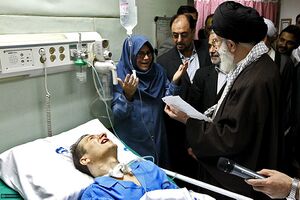Coma Recovery Scale (Revised)
Original Editor - Wendy Walker
Top Contributors - Wendy Walker, Kim Jackson, Naomi O'Reilly, Simisola Ajeyalemi, WikiSysop, Lucinda hampton and Olajumoke Ogunleye
Objective[edit | edit source]
The Coma Recovery Scale (CRS-R) , also known as the JFK Coma Recovery Scale - revised, is used to assess patients with a disorder of consciousness, commonly coma.[1] It may be used to differentiate between vegetative state (VS) and minimally conscious state (MCS).[2] It can also be used to monitor emergence from minimally conscious state (EMCS or MCS+).[2]
Intended Population[edit | edit source]
- Traumatic Brain Injury (TBI)
- Stroke (CVA)
- Brain Tumour
Method of Use[edit | edit source]
The CRS-R consists of 23 items, grouped into 6 sub-scales:
- Auditory
- Visual
- Motor
- Oromotor
- Communication
- Arousal
The lowest score on each sub-scale represents reflexive activity; the highest represents behaviors mediated by cognitive input. The total score ranges between 0 (worst) and 23 (best). This measure takes a minimum of 25 minutes to complete.
Equipment Required[edit | edit source]
- Instruction Sheet
- Scoring Sheet
- 2 Common Functional Objects (often a cup and a hairbrush or comb)
- An object which produces a loud noise
- Brightly Coloured Object
- ADL Items, e.g. toothbrush, phone
- Hand-held Mirror
- Baseball Sized Ball
- Pencil
- Tongue Depressor
Languages[edit | edit source]
Available in several languages. As well as the original English version, there are French, German, Italian, Spanish, Dutch and Norwegian translations available.
Evidence[edit | edit source]
Giacino,Kalmar and Whyte [1] studied 80 patients with severe acquired brain injury. These individuals were admitted to an inpatient Coma Intervention Programme with a diagnosis of either vegetative state (VS) or minimally conscious state (MCS). They compared the CRS-R to the Disability Rating Scale (DRS), and found that the total scores showed "significant correlation" between the 2 scales, which indicates acceptable concurrent validity. In addition, the CRS-R was able to distinguish 10 patients in an MCS who were scored as in VS by the DRS.
Reliability[edit | edit source]
Test-retest Reliability[edit | edit source]
Disorder of Consciousness Presentation - TBI (Traumatic Brain Injury), CVA (Stroke), hypoxi-ischaemic Brain injury and Tumour[1]:
n=20; mean age = 36.7 years (ranging from 17 to 57 years); mean time post injury = 57.15 days (range 22 to 169 days).
- Excellent test-retest reliability (Spearman rho = .94)
Inter/Intra-rater Reliability[edit | edit source]
Disorders of Consciousness Presentation (variety of neurological conditions, including TBI (Traumatic Brain Injury)[2]:
n=77; age range 19-86 years; 43 patients 1-27 days post injury, 34 27 days to 24 years post injury.
- Excellent reliability for total score (k=.80)
- Excellent reliability for subscales:
Auditory k=.82; Visual k=.85; Motor k=.93; Oromotor k=.92; Communication k=.98; Arousal k=.74.
Validity[edit | edit source]
This scale shows excellent concurrent validity as it correlates significantly with total scores on the orginal CRS and the DRS[1]:
- Concurrent validity with CRS: Spearman rho = .97
In addition, in the original study by Giacino, Kalmar & Whyte[1], which had 80 inpatients with severe ABI, the CRS-R was able to distinguish 10 patients in an MCS who were misclassified as being in a VS by the DRS.
Sensitivity and Specificity[edit | edit source]
Sensitivity and Specificity of the Coma Recovery Scale-Revised Total Score in Detection of Conscious Awareness.
Bodien et al, 2016[3]:
- CRS-R total score of 10 or higher yielded a sensitivity of .78 for correct identification of patients in MCS or EMCS
- CRS-R total score of 10 or higher gave a specificity of 1.00 for correct identification of patients who did not meet criteria for either of these diagnoses (i.e, were diagnosed with vegetative state or coma)
Miscellaneous[edit | edit source]
The Center for Outcome Measurement in Brain Injury (COMBI) has a useful page on the CRS-R http://www.tbims.org/combi/crs [4]
Recommendations[edit | edit source]
The American Congress of Rehabilitation Medicine, Brain Injury - Interdisciplinary Special Interest Group set up a Disorders of Consciousness Task Force to conduct a systematic review of assessment scales for DOC (Disorders of Consciousness) and establish recommendations for use in clinical settings[5].
The conclusion was that the CRS-R was the most appropriate scale to assess DOC, scoring better than all the other scales examined, (which included SMART, WNSSP, SSAM, WHIM, DOCS).
Links[edit | edit source]
CRS-R Administration and Scoring Guidelines (Updated)
References[edit | edit source]
- ↑ 1.0 1.1 1.2 1.3 1.4 Giacino, J. T., K. Kalmar and J. Whyte (2004). "The JFK Coma Recovery Scale-Revised: measurement characteristics and diagnostic utility." Arch Phys Med Rehabil Dec 2004: 2020-9
- ↑ 2.0 2.1 2.2 Diagnostic accuracy of the vegetative and minimally conscious state: Clinical consensus versus standardized neurobehavioral assessmentfckLRSchnakers C, Vanhaudenhuyse A, Giacino J, et al. "Diagnostic accuracy of the vegetative and minimally conscious state: Clinical consensus versus standardized neurobehavioral assessment". BMC Neurol. 2009; 9:35.
- ↑ Sensitivity and Specificity of the Coma Recovery Scale-Revised Total Score in Detection of Conscious Awareness.fckLRBodien YG, Carlowicz CA, Chatelle C, Giacino JT. Arch Phys Med Rehabil. 2016 Mar;97(3):490-492
- ↑ Giacino, J & Kalmar, K. Coma Recovery Scale-Revised. The Center for Outcome Measurement in Brain Injury 2006 ( accessed March 13, 2016 ).
- ↑ Assessment scales for disorders of consciousness: evidence-based recommendations for clinical practice and research.fckLRAmerican Congress of Rehabilitation Medicine, Brain Injury-Interdisciplinary Special Interest Group, Disorders of Consciousness Task Force1, Seel RT, Sherer M, Whyte J, Katz DI, Giacino JT, Rosenbaum AM, Hammond FM, Kalmar K, Pape TL, Zafonte R, Biester RC, Kaelin D, Kean J, Zasler N. Arch Phys Med Rehabil. 2010 Dec;91(12):1795-813







